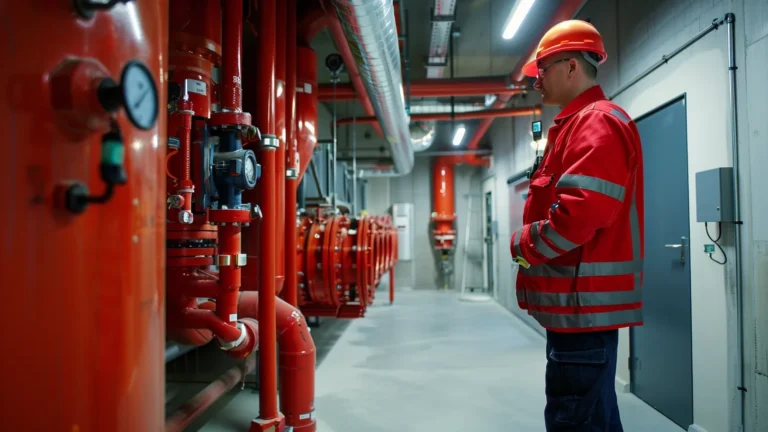Discover the key strategies to optimize your property. Learn how to cut operating costs, reduce energy consumption and increase comfort for residents and employees in our guide.
Our article shows you what lies behind intelligent building management – from technological innovation to sustainable resource management.
Find out how modern approaches and digital solutions can help you realize the full potential of your property.
List of contents
What is building management?
Building management is a subarea of facility management which refers to the operation, maintenance and upkeep of a property. The goal is to keep the building in the best possible condition so that it can serve its purpose.
- Building management means more than just classic building maintenance. From tenant satisfaction to economic success – everything is connected.
- Depending on the infrastructure, building management can quickly become complex. The monitoring of key figures and the use of special software help you to keep an overview.
- Targeted building management optimization can save resources, increase efficiency and make it easier to achieve business goals. Efficient facility management is the key to economic success.
Tasks and objectives of building management
Larger buildings such as office buildings or hotels are very complex nowadays. Without good management, it is difficult to handle the numerous facilities and systems.
Building management is about designing, installing, and maintaining these systems. In addition, activities such as controlling are carried out to ensure that the buildings can be used optimally.
The goal of building management is to ensure that buildings and infrastructures function, can be used safely and operated economically. It also helps maintain the long-term value of real estate.
Financial aspects such as operating costs, maintenance contracts and administrative costs, as well as environmental aspects such as energy waste and carbon emissions, play an important role.
Building management includes:
- Building cleaning and facade cleaning
- Building equipment (heating, ventilation, elevators, sensors, generators, etc.)
- Electrical installations, plumbing and energy costs
- Building structure (doors, roofs, windows, etc.)
- Exterior of the building (gardens, terraces, entrances, surveillance cameras, etc.)
For whom is building management worthwhile?

In most cases, a professional building management solution makes sense once a building reaches a certain size and complexity. For an apartment building with 6 apartments, a conventional property management company is usually sufficient. Nevertheless, the demarcation is not always clear.
While a small craft business may be able to manage its premises itself, a medium-sized company with 40 employees, on the other hand, must outsource building management and rely on a professional service provider due to the size of its property.
We have listed some examples that require comprehensive building management:
- Office Buildings & Skyscrapers
- Schools & Universities
- Hospitals & Laboratories
- Hotels
- Swimming pools
- Public office buildings (city halls, city administrations, barracks, etc.)
- Group locations
- Airfields
- Server locations
- Large apartment buildings
- Factories & Power Plants
- Great recreational facilities
The 3 core areas of building management
Building management is subdivided into the areas of technical facility management, infrastructural building management and commercial building management.
Technical building management
Technical building management comprises the management and maintenance of the technical installations in a building.
Modern technical equipment makes the operation of buildings more efficient and pleasant. Often, however, it is also unavoidable, like the IT infrastructure, which requires regular maintenance and servicing needed.
As buildings have to comply with more and more legal requirements and achieve a high level of operational safety, technical building management ensures that all the legal requirements be complied with. Technical building management is heavily dependent on external service providers to take care of regular maintenance tasks.
Overview of the technical installations
- Plants for the supply of electricity, heat, cooling, fresh air or compressed air
- Sanitary engineering, water supply and sewage disposal
- Elevators, transport equipment
- Fire protection equipment and signage for flammable substances
- Wires, connections, computers, printers, copiers, etc.
Tasks of the technical building management
- Environmental audits and measurements related to energy consumption, waste, pollutants, hazardous substances or emissions
- Renovations and modernizations
- Acceptance, commissioning, operation, monitoring and, if necessary, decommissioning of all equipment
- Service and maintenance
- Defect analysis and repair
- Carrying out technical inspections and tests
- Documentation and reporting for traceability of all measures
Infrastructural building management
In order for people to work undisturbed in a building, various aspects such as cleanliness, safety and waste disposal must be ensured. The infrastructural building management includes all supporting services that improve the use of infrastructures.
Tasks of infrastructural building management
- Cleaning buildings, paths and streets
- Organize security service
- Maintain buildings and outdoor and green areas
- Carry out winter service
- Dispose of waste and hazardous waste
- Manage fleet
- Manage parking space
- Manage keys or access systems
- Internal mail
- Manage moves within the company
- Catering, canteen operate
In some cases, individual tasks are performed by external service providers: The commercial cleaning cleaning is carried out by a cleaning company or the canteen is operated by a restaurant.
Commercial building management
Investments and costs are associated with the tasks of building management on technology and infrastructure. These must be considered commercially. This is the task of the commercial building management.
Tasks of commercial building management
- Operating cost management
- Management of service providers and monitoring of services
- Procurement of buildings, rooms, facilities and infrastructure
- Accounting
- Management of necessary insurances: Building insurance, glass insurance, liability insurance, contents insurance, etc.
- Planning of investments, budget and financing
The 7 most important key figures of building management

Establishing and analyzing the right metrics in building management is essential to successfully manage and maintain a property. We reveal the seven most important key figures.
1. Percentage of reactive maintenance
Similar to healthcare, facility management costs are significantly lower for preventive measures than for reactive ones. Your employees are always on site only when the fire has already broken out? That should change quickly. In technical building management, the percentage of reactive maintenance should not exceed 20 to 30%.
2. Percentage of preventive maintenance
The percentage of preventive maintenance should be significantly higher, that is, that of reactive maintenance. In technical building management, make sure enough routine inspections and maintenance are performed. This will help you avoid accidents and unplanned repairs.
3. Number of orders in backlog
A certain amount of maintenance backlog is unavoidable. However, if there is a significant maintenance backlog, it is only a matter of time before you are faced with an increasing number of malfunctions, equipment failures and extended downtime.
4. Budget planning and compliance
In commercial building management, the budget is distributed optimally so that all departments have the money they need. If this is not the case or even if less costs have been incurred, it is time for optimization measures.
One of the tasks of a facility manager include having a good overview of finances and making adjustments as necessary.
5. Energy measurement
In building management, the costs for energy supply are measured.
Detailed energy data, such as units per production and energy generated and purchased on site per month, is collected.
In this way, facility managers monitor the extent to which they have achieved their sustainable goals. If the results are positive, the same plan can be pursued. However, if excessive bills occur, it is advisable to set a sustainable target.
6. Number of complaints from end users
All employees and visitors must be able to carry out their activities without any problems and find optimal conditions. If the sanitary facilities are not working or a corridor is without light, this will lead to complaints to the infrastructural building management. The aim is to keep these complaints to a minimum.
7. Average time to complete an order
Building management often reveals inefficiencies that can be avoided with the right facility management software. This time can be a good indicator of the efficiency of workflows and external services in commercial facility management.
Wowflow’s solution is specifically tailored to the needs of facility management teams. Manage facility management tasks and processes efficiently with Wowflow. Book demo here!
9 best practices for building management
In practice, there are proven methods to master all types of facility management. We have summarized the 9 most important measures for you.

1. Improve your asset and order management
Knowing what the next important work order is or where the malfunction was reported can save you time and energy.
Various tools can support you in this process, such as BIM software, CAFM or CMMS, which offer work order or asset management functions.
Wowflow’s intuitive app helps facility management teams manage work orders and assets with less effort and time. Learn more here!
- Order management: Optimum administration of tasks and processes in facility management
- CMMS: Software solution for plant and order management
2. Take into account the entire life cycle of the plant
To ensure the availability and reliability of all equipment, it is important to consider all phases of the equipment life cycle.
The life cycle of equipment is an important factor in productivity, because the longer a plant can be used effectively, the better its profitability.
3. Buy compatible devices
Another best practice in building management is to purchase equipment that is compatible with existing equipment, making it easier to operate and maintain.
This not only reduces the number of spare parts that need to be in stock at all times, but also allows you to optimize the training of technicians.
The same principle can be applied to software solutions and their optimal integration into your daily workflow.
4. Invest in networked products
Installing IoT devices is definitely one of the most promising building management practices.
Preventive maintenance is closely linked to condition monitoring and the IoT. Smart technology makes it possible to reduce energy waste and make buildings more sustainable. It paves the way for Smart Buildings.
5. Delegate responsibilities and establish service level agreements
To avoid conflicts, internal and external responsibilities must be defined. It is important to establish communication channels and set a service level agreement with specific performance indicators.
Wowflow helps you collaborate easily with large teams and external service providers. Learn more here.
6. Maintain your inventory documentation
Capture the inventory and actual condition for your building management. An inventory documentation is necessary to perform maintenance, operational tasks or advanced simulations.
7. Keep a record of your building management goals
Clarify which goals in the context of building management are important for your company and should be pursued in addition to the economic goals.
For example, the following objective could be part of building management:
The number of workplace accidents must be reduced by 25% within the next 12 months by introducing a safety training program for all employees.
8. Offer training to your employees
Training technicians and employees on their equipment and safety systems is critical. Many managers invest in equipment that staff cannot operate properly, which negatively impacts facility management and profitability.
9. Introduce a building management system
Facility management is a demanding job. A building management system is therefore essential.
A building management system is a system that manages and monitors all building systems, including the electrical system, HVAC system, renewable energy generation, and electric and gas meters.
This system is designed to automate and optimize maintenance, energy consumption, safety and asset management.
It allows you to manage all contracts, monitor staff efficiency and management effectiveness – keeping the building in the best possible condition for many years.
What are the advantages of building management software?

Although the average cost of building management software is still high, the investment often pays off after 5 years. We have listed the 5 main benefits of building management software:
1. EU compliance
According to the EU Directive on the Energy Performance of Buildings or Energy Performance Buildings Directive, building management systems are required by law in commercial buildings with a rated output of more than 290 kW.
This is one of the EU’s most important projects to reduce the impact of climate change and global warming.
Buildings are responsible for 40% of energy consumption and 36% of CO2 emissions in the EU, making them the largest energy consumer.
2. Energy saving and environmental protection
A building without building management software consumes 10-30% more energy than a comparable building with a building management system or also called a smart building.
Building management software reduces energy consumption and costs by controlling HVAC systems, lighting, and more. automated. This reduces the environmental impact of your business.
3. Preventive maintenance
Building management software leads to increased technical efficiency. By centralizing all information, assets can be better managed and monitored, reducing reactive maintenance. Preventive maintenance reduces maintenance costs by 18-25% and extends equipment life by about 20%.
Building management software enables modern maintenance and planning of preventive measures.
4. Improved comfort and safety
A building management system allows better control of room temperature and other air quality indicators in real time. In highly complex buildings, such as hospitals or refineries, a building management system promotes optimal working conditions and provides greater safety.
With access controls and alarms, building managers can reduce risks and respond quickly in emergencies.
5. Facility management
Building management software shows facility managers where and how they are wasting time. Analyze your data through centralized dashboards and make informed decisions to improve efficiency. Automate your reporting and management tasks.
Facility management teams are already saving 50% of their administrative workload with Wowflow. Our easy-to-use app makes creating and sharing professional PDF reports a breeze. Here Book a demo!
Types of building management software

As a sub-area of facility management, building management software can be integrated as a subsystem into many facility management technologies.
There are different types of facility management software and building management software, each designed for specific tasks or operations.
We have listed the 6 most important ones:
1. Computerised Maintenance Management System (CMMS)
2. Building Automation System (BAS)
A Building Automation System is a building management software and hardware system that monitors the mechanical, electrical and plumbing systems of buildings.
It usually includes energy meters, IoT sensors to measure environmental conditions, fire alarms, carbon monoxide detectors, and more. The sensors relay this data to a central dashboard for analysis and control.
3. Energy Management System (EMS)
An energy management system manages and optimizes a building’s energy use by tracking consumption, identifying waste, and automating energy-saving measures.
For example, the software can turn off lights, HVAC units and heaters when no one is in a room or building to save energy.
It is possible to integrate an energy management system with CAFM software as a module.
Wowflow’s innovative solution integrates effortlessly with your existing systems: No more cumbersome installations and complicated customizations. Here Book a demo!
4. Systems for access control
Access controls are used to increase security. But they also enable efficient business processes and smooth building management.
An access control system is an electronic security system that uses an identification feature – such as an access card – to authorize people to enter certain areas.
The access control system records who has gained access and when. Therefore, the system can provide valuable data. You control how your buildings and sites are used and how busy they are.
5. Enterprise Resource Planning software
Enterprise Resource Planning (ERP) includes all core processes necessary to run a business: Finance, Human Resources, Manufacturing, Logistics, Services, Procurement and others.
ERP systems connect a variety of business processes and enable data to flow between them.
Automation simplifies numerous processes, such as purchase orders. At the same time, extensive amounts of data are collected and stored over time, including product and inventory data as well as personnel and HR data.
6. Property management software
A property management software facilitates the work of property managers. It improves communication with tenants and owners and enables access to documents from anywhere.
The software performs essential tasks such as billing of various types, especially service charge and heating cost billing. It also allows for the fair distribution of service charges among tenants based on a defined distribution formula.
Thus, property managers can be sure that all settlements are carried out correctly and in a legally compliant manner.
The development of smart buildings

As building management becomes more modern and efficient, we see the introduction of so-called smart buildings.
Smart buildings are buildings with automated building management. Many devices such as heating, ventilation, air conditioning, lighting and security are controlled remotely.
You can set schedules and alarms, adjust settings, and monitor performance from a single interface.
These control capabilities not only improve the efficiency of building management, but also provide greater comfort and convenience to occupants.
For example, IoT-enabled devices can feed data into building management software such as CAFM, CMMS or ERP, which simplifies reactive maintenance planning and condition monitoring.
6 Examples of building management systems in smart buildings:
- HVAC: Thanks to IoT sensors, HVAC settings can be automatically adjusted to save energy and provide maximum comfort.
- Lighting: An automation system controls the building’s lighting based on occupancy and daily hours of sunlight.
- Air purification: The system controls ventilation based on measurements, which is more efficient than human control.
- High-tech security: Access control restricts access to certain areas of the building through fingerprint readers or ID cards. Surveillance technology and other audiovisual solutions.
- Motion sensors: They indicate which rooms are occupied or not (e.g. to know how many people have used the sanitary facilities and when they need to be cleaned).
- Digital Signage: State-of-the-art solutions replace traditional signage and internal communication.
Summary
Facility management comprises three central areas: technical facility management, commercial facility management and infrastructural facility management. Good building management can reduce operating costs and increase productivity.
Each area can be optimized using different methods or tools so that you always have it under control.
Technical building management includes tasks such as maintenance, servicing and cleaning. Modern CAFM and CMMS systems facilitate asset management and order management here.
In commercial building management, the focus is on topics such as cost planning or budgeting, which can be covered by an ERP system.
Infrastructural building management prioritizes the well-being of people in the building. Here, an access control system can ensure that everyone is safe and can go about their activities undisturbed.
In addition to these tips, we also recommend keeping an eye on the trend toward smart buildings. Through automation and digitization, they form the future of sustainable building management.
Frequently asked questions
Space management encompasses the management of an organization’s space supply. It provides an accurate overview of available land and supports strategic land use planning.
Space management forms the basis for areas such as occupancy management, relocation planning, room reservation.
The DIN 32736 standard defines terms and describes the services of building management. For example, technical building management (TGM) in accordance with DIN 32736 includes all services that serve to maintain the technical function and availability of a building.
The management of a hotel is an example of facility management. Duties include setting up and maintaining a room reservation system, cleaning the premises, hiring room service staff, etc.



